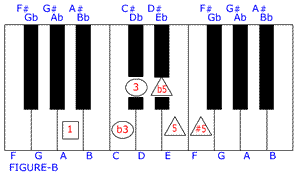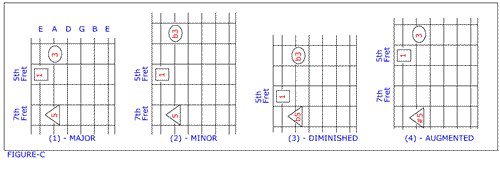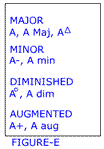
THE
GUTS OF A CHORD SHAPE
By huskybones
Intro
This article gets into chords a little deeper than just memorizing shapes. I'll try to explain how to construct your own chord shapes and arpeggios.
Chord Theory
There are four basic chord types. Their names are major, minor, diminished, and augmented. If the notes are played one at a time then it's called an arpeggio. If they are played together then it's a chord.
Each of these chord types is made of three notes. These 3 note groups are called triads. The notes in the triad have a certain relationship to each other, which is described in terms of intervals. Each triad has a root (1), a third, and a fifth. The root is the number one note for identifying the chord. The third and fifth note further indentify the chord and can be altered as you'll see later.
Take a look at Figure-A.

On the keyboard, the notes are laid out in half steps (chromatically) with only one place to play each note, so let's start our interval discussion there. The root note in all examples will be on A. The third interval is made by playing two consecutive whole steps from the root. In Figure-A you'll see that the first whole step goes from A, then skips A#, and lands on B. A whole step just skips the chromatic note in between. The next whole step starts on B, skip C, land on C#. Why C# and not D? Easy, the interval we're playing is a "third" or three notes away from the root. A-B-C is three notes, and in the scale the C is sharp. Likewise the next interval, the fifth, is five notes away from the root. A-B-C#-D-E gives you the name of the fifth note. You can build this by playing up the major scale: A-whole step-B-whole step-C#-half step-D-whole step-E. The intervals that we've laid out give us an A Major chord. If all this seems like a lot of counting, don't worry because once you apply the notes to your bass/guitar neck they quickly fall into some fairly regular patterns.
As I said there are four basic triads, so let's look at those:
Major - built with the 1-3-5 notes
Minor - uses 1-b3-5. We flat(b) the third by bringing it down a half step.
Diminished - chords use a flat(b) third and a flat(b) fifth 1-b3-b5.
Augmented - uses a sharp fifth so it looks like 1-3-#5.
Locate these triads on the keyboard diagram (Figure-B) and take note of the step or interval patterns.

Chords on the Bass or Guitar
In Figure-C I've diagrammed all four triads with A as the root and using the bottom 2 guitar strings.

Guitar and Bass players can use this information. This gives you the arpeggio and if you take the fifth note in each chord and move it to the D string, you'll have a usable chord shape. In Figure-D, I've shown a standard bar chord shape with all the modified notes (b3, b5, #5) that we've talked about. If you want a little more of a challenge, get one of those books with 5000 guitar chords (bass players can do this too!) and identify the roots, thirds and fifths of the different shapes.

Chord Symbols

As a wrap-up, it's good to know how these chords are called out on charts. Figure-E shows some common symbols. Hope this helps.
-take it easy
-hb
By huskybones
Intro
This article gets into chords a little deeper than just memorizing shapes. I'll try to explain how to construct your own chord shapes and arpeggios.
Chord Theory
There are four basic chord types. Their names are major, minor, diminished, and augmented. If the notes are played one at a time then it's called an arpeggio. If they are played together then it's a chord.
Each of these chord types is made of three notes. These 3 note groups are called triads. The notes in the triad have a certain relationship to each other, which is described in terms of intervals. Each triad has a root (1), a third, and a fifth. The root is the number one note for identifying the chord. The third and fifth note further indentify the chord and can be altered as you'll see later.
Take a look at Figure-A.

On the keyboard, the notes are laid out in half steps (chromatically) with only one place to play each note, so let's start our interval discussion there. The root note in all examples will be on A. The third interval is made by playing two consecutive whole steps from the root. In Figure-A you'll see that the first whole step goes from A, then skips A#, and lands on B. A whole step just skips the chromatic note in between. The next whole step starts on B, skip C, land on C#. Why C# and not D? Easy, the interval we're playing is a "third" or three notes away from the root. A-B-C is three notes, and in the scale the C is sharp. Likewise the next interval, the fifth, is five notes away from the root. A-B-C#-D-E gives you the name of the fifth note. You can build this by playing up the major scale: A-whole step-B-whole step-C#-half step-D-whole step-E. The intervals that we've laid out give us an A Major chord. If all this seems like a lot of counting, don't worry because once you apply the notes to your bass/guitar neck they quickly fall into some fairly regular patterns.
As I said there are four basic triads, so let's look at those:
Major - built with the 1-3-5 notes
Minor - uses 1-b3-5. We flat(b) the third by bringing it down a half step.
Diminished - chords use a flat(b) third and a flat(b) fifth 1-b3-b5.
Augmented - uses a sharp fifth so it looks like 1-3-#5.
Locate these triads on the keyboard diagram (Figure-B) and take note of the step or interval patterns.

Chords on the Bass or Guitar
In Figure-C I've diagrammed all four triads with A as the root and using the bottom 2 guitar strings.

Guitar and Bass players can use this information. This gives you the arpeggio and if you take the fifth note in each chord and move it to the D string, you'll have a usable chord shape. In Figure-D, I've shown a standard bar chord shape with all the modified notes (b3, b5, #5) that we've talked about. If you want a little more of a challenge, get one of those books with 5000 guitar chords (bass players can do this too!) and identify the roots, thirds and fifths of the different shapes.

Chord Symbols

As a wrap-up, it's good to know how these chords are called out on charts. Figure-E shows some common symbols. Hope this helps.
-take it easy
-hb